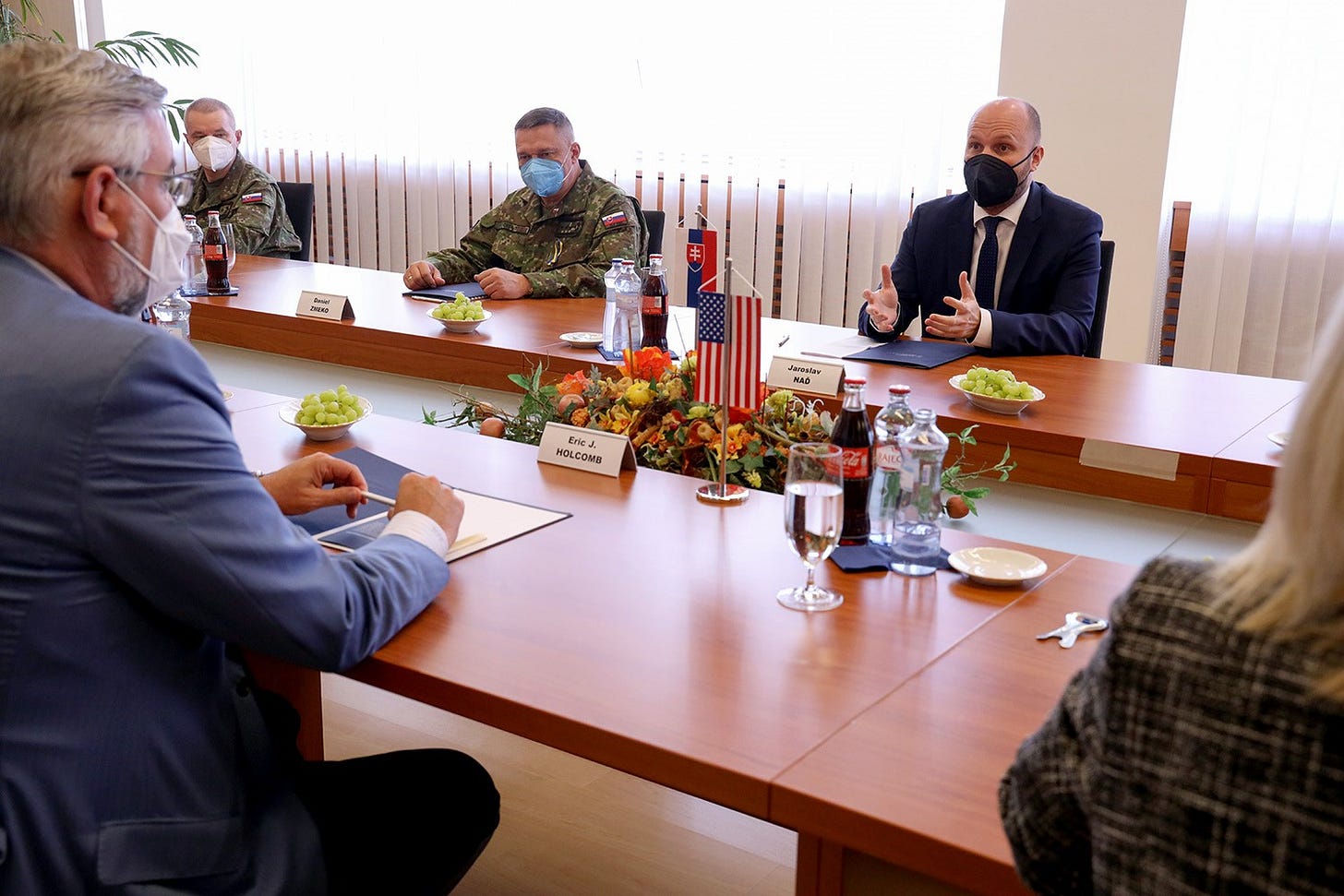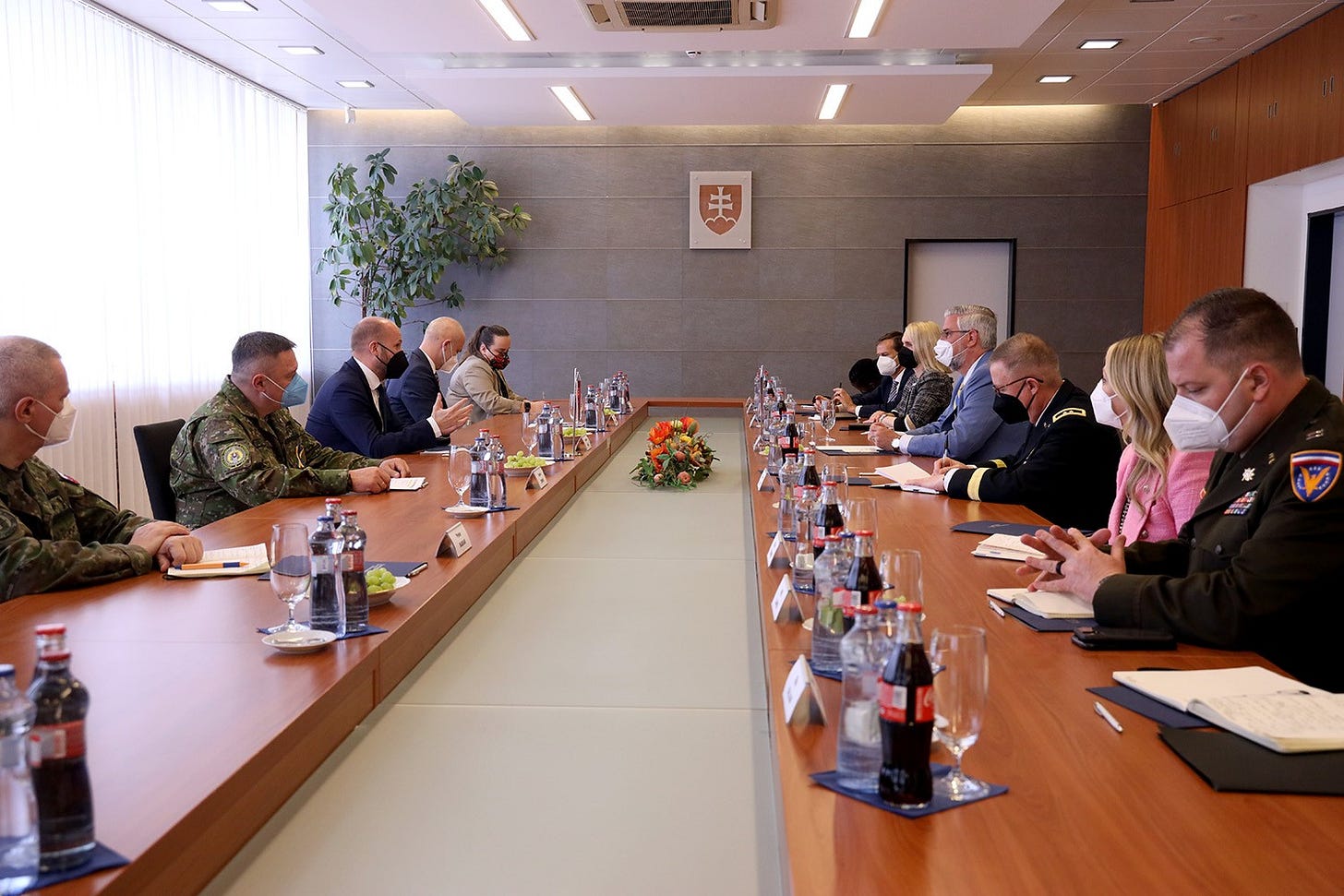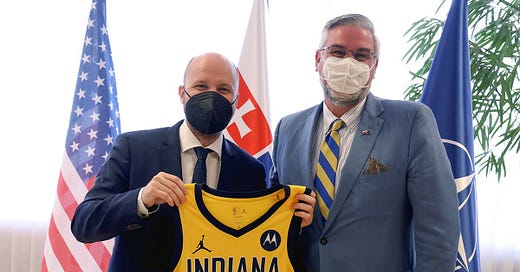What is Gov. Eric Holcomb really doing in Slovakia?
On Tuesday, Holcomb and the head of the Indiana National Guard met with Slovakia’s minister of defense and with its top general.
The U.S. Embassy in Slovakia said Wednesday on Twitter that in that meeting, they talked about “expanding” military cooperation between Slovakia and Indiana.





This is interesting because the Indiana National Guard said two weeks ago that this was a routine sort of trip — nothing unusual!
But “expanding” does not mean routine or status quo. It means a change.
It means something is happening.





Now, why would Indiana be involved with any military operation in Slovakia?
Indiana is not a sovereign nation. It doesn’t have its own foreign policy. It doesn’t go to war. It doesn’t have its own military.
But it does have the Indiana National Guard and what some people want more of in Eastern Europe, lined up near the Russian and Ukrainian borders — American troops. A lot of them.
Here’s the situation:
Slovakia shares a border in the east with Ukraine, and like Ukraine, is a Slavic nation. It is also a NATO country, though prior to the recent onslaught of news about Russia’s “invasion” of Ukraine, a poll showed most people in Slovakia thought the United States was to blame for the problems between Ukraine and Russia — not Russia.
On February 9, Slovakia’s parliament approved a defense cooperation agreement with the U.S. government to allow the United States to expand its military presence in Slovakia.
In mid-March, its parliament approved the deployment of up to 2,100 NATO troops in the country, including troops from the United States, as part of a NATO “enhanced forward presence.”
And last week, NATO leaders made the decision to expand NATO’s military presence in the east, increasing the number of troops in countries including Slovakia, Romania, Bulgaria and Hungary.
What’s concerning is that the expansion of NATO eastward, and the potential admission of Ukraine into NATO, is at the heart of the current troubles, as Russian President Vladimir Putin has repeatedly said that one condition of ending the war in Ukraine is a guarantee that Ukraine — most of which was part of Russia from the 1400s until Ukraine was declared an independent country in 1991 — would never become a member of NATO.
Does the United States government want the war in Ukraine to continue?
Yes, certainly, because it makes it that much easier to go after Russia and to sell it as a “defense of Ukraine.”
And people who’ve studied U.S. policy towards Russia have concluded that what the United States really wants is to “break Russia.”
(These two words — “break Russia” — were used by former Secretary of State Henry Kissinger to sum up the 1992 doctrine written by neocon warmonger Paul Wolfowitz — a doctrine that has remained in effect and poisoned American foreign policy for two decades — including in Ukraine.)
Russia is not a communist country. It’s a Christian nation. Ninety percent of Russians call themselves Orthodox Christians and the Russian government is allied with the Russian Orthodox Christian Church almost as it was in the time of the tsars, with Putin actively involved in rebuilding Orthodox churches across the country — churches that had been destroyed by the communists.
So what is Indiana doing?
Conveniently, the Indiana National Guard has a 25-year partnership with Slovakia that has involved joint military training exercises. Who are we training them to fight?
In 2019, a Guardsman wrote an article describing one of those joint training exercises, held at a military training center in Lest, Slovakia, in an old Soviet-era barracks. In the exercises, soldiers went from room to room to train how to fight in an urban warfare scenario.
The goal, the Guardsman wrote in the article on the National Guard’s website, was “reinforcing old and learning new war-fighting skills alongside Slovak allies to be a more lethal and effective unit.”
Whatever is being planned for the troops with the Indiana National Guard — whether it’s an invasion of Moscow or moving in to Ukraine to fight Russians from Kiev, Holcomb seems to be fully on board.
He gave a long interview to the Northwest Indiana Times this week in which he seemed to support the overthrow of Russian President Vladimir Putin.
“I think the sooner he leaves the international stage the better for humanity, and if he wants to put his people first he would do just that,” Holcomb said.
He also told Fox59 in an interview that he thinks Russia should be declared a state sponsor of terrorism.
In early March, in talking of his call for the state to divest itself of all Russian-related companies and funds, Holcomb said the state of Indiana “is not going to be part of Putin’s blood-oil machine.”
"If you're a liquor store owner and you want to fill up a garbage can with Russian vodka, I'll throw the match and light it on fire," he added.
Speaking of lighting things on fire, the U.S. Ambassador to Slovakia is a career diplomat named Bridget Brink who was hired to work under Victoria Nuland at the State Department in the summer of 2016, as the deputy assistant secretary of the European bureau — which is in charge of U.S. foreign policy toward Europe.
I’m sure Brink is a nice lady. But there’s very little chance that she does not share Nuland’s predilection for regime change. It was Nuland who was tasked with rustling up European support for the U.S. war in Afghanistan — a military and foreign policy mistake of epic proportions. Nuland was also an adviser to Dick Cheney on the Iraq War, and most importantly, was heavily involved, most likely with our CIA, in overthrowing the elected leader of Ukraine, Viktor Yanukovych, who was friendly with Russia, and replacing him with Petro Poroshenko.
On a leaked phone call, she could be heard telling the U.S. ambassador to Ukraine who should serve in Ukraine’s government, and who should not.
Nuland is now is now Undersecretary of State for Political Affairs.
And she seems determined to use Ukraine to provoke and stress Russia, as the Wolfowitz doctrine outlined.
Brink reports to her.
Does Holcomb know this?




Notes:
I pressed the Indiana National Guard in mid-March to explain what, exactly, the Guard’s mission is in Slovakia and what military or humanitarian support the Guard is now providing to Slovakia.
A spokesperson for the Indiana National Guard responded:
Through our State Partnership Program, the Indiana National Guard has a long history of training with and supporting the Slovakian military. Indiana Guardsmen frequently travel to Slovakia for a wide variety of combined training exercises. Maj. Gen. Lyles visits our partner nations to strengthen these relationships.
I pressed again, asking: “Is the Indiana National Guard involved in a humanitarian or military mission in Slovakia or will it be, and how much will this cost taxpayers?”
And:
“What is the mission? And if there is no mission, why is the Indiana National Guard there?”
The spokesperson for the Guard, Lt. Col. Randi Bougere, responded:
Overall, these visits are common. We visit Slovakia and our other partner nation of Niger, several times throughout the year.
But now we have the new information from the U.S. Embassy about an expansion of military cooperation, and about our governor and head of the Indiana National Guard meeting with the Slovakian defense minister and Slovakia’s top general. Certainly, they weren’t meeting to talk about the weather!
***************
Bonus: Listen to defense expert Scott Ritter explain why NATO is really an offensive alliance, not a defensive one:






He has his sights set on a federal position(senator) and these international trips give him some "foreign policy" chops. No telling what kind of destruction he is plotting.